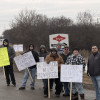The decade of the 2000s was the worst ever for stocks, says Yale finance professor
FROM THE 1960s to the 1990s, participants in the Boilermaker- Blacksmith National Pension Trust enjoyed dozens of increases in their pension benefit formula, with no downward adjustments of any kind. But last October participants in the multi-employer plan learned, like millions of other American workers, that their pension had been hit hard by the global financial meltdown and stock market collapse of 2008 — so hard that the plan had to make a negative adjustment affecting future pension accruals for only the third time in its history.
Over the next five years, more money will go into the fund on behalf of participants than in 2008 (in some cases funded by negotiated pay cuts). But the amount used to calculate retirement benefits will remain at the contribution rate of September 30, 2008. The good news is that this adjustment does not reduce anyone’s current benefits, nor does it change the early retirement eligibility rules, and it will be sufficient to keep the plan healthy for the foreseeable future — barring additional economic downturns.
“Pension watchdog rates Boilermaker-Blacksmith National Pension Fund among the top 22 multi-employer funds.”
Those facts are not much comfort for Boilermakers used to seeing their benefits increase on a regular basis. It is only natural to wonder what has happened in recent years to require three adjustments since 2003.
Yale finance professor William Goetzmann may be able to shed some light. His analysis of stock price trends since the 1820s suggests that the period 2000 - 2009 may have been the worst calendar decade ever for stocks in the United States. Even the decade of the Great Depression (1930-1939) had enough good years for stock prices to outpace 2000-2009.
The 2000s started with three bad years in a row — 2000, 2001, and 2002 — and ended with 2008, one of only two years in history when the U.S. stock market has lost more than 40 percent of its value. Five years of pension gains were wiped out in 2008, according to a pension funding report from Milliman, Inc., a global consulting and actuarial firm. The lost value totaled $7.2 trillion, or about half of that year’s U.S. gross domestic product.
Boilermakers may take some solace in the knowledge that their fund is doing better than many pensions. Pension watchdog knowyourpension.org rates it among the top 22 multi-employer funds.
Some Facts about the Boilermaker-Blacksmith
National Pension
- Created in 1960 to provide a pension for construction Boilermakers who may work for any number of employers throughout their careers.
- Not a part of or controlled by the Boilermakers union.
- A multi-employer Taft-Hartley trust, governed by a board of 18 trustees — nine union trustees appointed by the International President and nine employer trustees selected by the employers.
- Trustees set policy and oversee the trust fund.
- Trustees have a fiduciary responsibility to the fund, they must ensure that it can continue to provide pension benefits for all vested participants when they reach retirement age.
- Trustees do not manage the fund itself.
- Trustees hire administrators to run the daily operations of the fund and money managers to manage investments.
- The performance of the fund managers is reviewed regularly, and those who are underperforming are replaced.
- The full board meets twice a year — in January and June.
- The board does much of its business through four committees — the Executive, Appeals, Investment, and Pension Funding committees.
- These committees meet periodically throughout the year, sometimes in person and sometimes by teleconference.
- Trustees are not paid for their services.
- Trustees’ expenses related to travel, lodging, food, and other expenses while attending trustee meetings are reimbursed by the fund in accordance with the travel expense policy adopted by the board.





